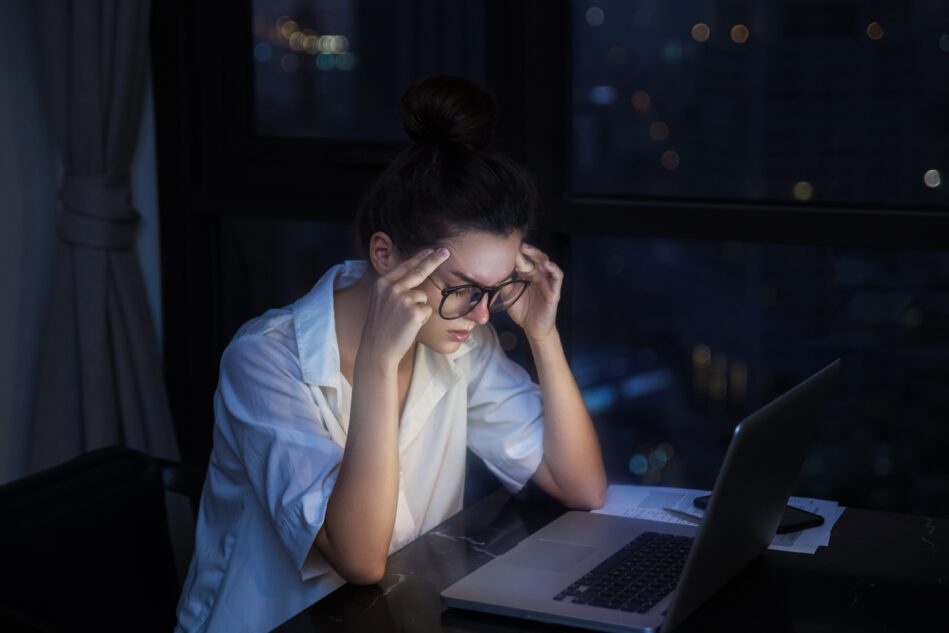The Covid 19 pandemic has changed the educational practices and norms for all of us. With the advent of significantly more virtual or remote learning, our kids and teens are being exposed to much more screen time than ever before. For people with headaches and migraines (and even those who do not), this can certainly increase headache pain.
Light sensitivity is a hallmark of migraine, and is much more common in those with chronic headaches of all kinds. Increased light exposure will often lead to a higher level of chronic headache pain and can be a trigger for migraine. Exposure to blue light emitted from screens is just one of the issues. Also problematic are those things that cause eye strain, such as increased light/dark contrast, flickering fluorescent lights and screens. In addition, postural issues, such as forward-flexed posture, can lead to neck and upper back strain, and contribute to all types of headaches.
There are a number of proactive strategies that can decrease the impact of increased screen time for everyone. The key is to identify what are the main culprits for you and/or your child and then to intervene.
Watch our exclusive interview with the author of this article, Vickie Karian, below:
Decreasing Blue Light Exposure For Reducing Migraines
Exposure to blue light, which is emitted from your many screened devices (phone, tablet, and monitor) is well known to interfere with normal Circadian rhythms, disrupt sleep and trigger migraine. This is why we advise putting away the devices an hour before bed during usual times. During these times, more actions need to be taken to decrease exposure.
Use a screen filter to decrease your blue light exposure: There are numerous ways to reduce your exposure, including using free software (f.lux), using a physical screen filter, or accessing software included in your device (night light on Windows devices or night shift on MacOS/iPhones). These will reduce the blue light exposure and also reduce contrast within your surroundings. Wear special glasses: Blue light blocking glasses can also be effective in reducing exposure. There are numerous brands at different price points, from less expensive from the drugstore to more expensive ones from brands such as Theraspecs, Axon Optics or MVMT. Start with a reasonably priced pair and assess how they work and if your child will actually wear them.
Many people with headaches and migraine use a combination of strategies to reduce their exposure to blue light.
Decreasing Eye Strain
Balancing the screen brightness with your surroundings: Too much contrast between the screen and the room light can cause significant eye strain. If you are spending time looking at a screen which is much brighter than the lights in the room around you, your eyes are doing a lot of work, balancing between the 2 environments. This causes eye strain, which can cause headache for anyone, and could easily trigger a migraine. Solution: Keep your room well lit to balance the light on the screen. Do not work in a dark room with the only light coming from the screen.
Increase the font size: Small font size makes your eyes work too hard, leading to eye strain. Solution: Change your default font size to 14 or higher.
Change the font style: Fonts that are called sans-serif (without tails) makes the writing clearer and easier to read, as compared to those with more detail. Solution: Change your font style from a default Times New Roman to another font, such as Arial or Calibri, without all the little tails on the letters (sans serif).
Clean/dust your screens: Dust and marks on the screen decrease sharpness, causing your eyes to work too hard. Solution: keep your screens and glasses clean.
Decreasing Postural Issues
Many people, children and adults alike, are struggling to figure out how and where to work from home. For many teenagers especially, it is not uncommon for them to spend most of their day on the bed, bent over their screen/laptop/tablet. This is not ideal for many reasons: prolonged hunching leads to neck and upper back strain and muscle tension, often leading to migraine or increased level of chronic headache and neck pain; lighting is generally less than ideal; typing in this position can lead to wrist strain.
Solution: Sitting at a desk or table, feet on the floor, back/spine straight and comfortable, head upright and looking forward with the screen at eye level, about 20-30 inches away. You might have to lower the chair or raise the screen to be at eye level. You might want to have several chairs to rotate, or try one of those stability ball chairs (strengthens your core and back while sitting).
General Strategies For Reducing Migraines
Taking back-to-back-to-back virtual classes is exhausting, especially when there is hardly any break. Getting up and moving, going to the bathroom, doing a few jumping jacks, running up and down the stairs, and doing 3 deep breaths, are quick ways to break away from the screen. This is beneficial for your head, body and your mood. Remember, when they were going to school, they moved in between every class, the break was built-in.
Hydration is crucial for anyone with headaches, and especially when they are off their usual school schedule. They should have their water bottle at their desk. It is helpful to set ‘water goals’, such as finishing a full bottle by 11a and a second one by 3p. Drinking a lot also creates incentive to move and take a break.
A word about stress and school: Stress and anxiety especially around school are the most common triggers for migraine and chronic headache. At the start of the pandemic, it was notable that many of my patients were doing much better with their headaches. Remote schooling was variable and not terribly stressful for the kids. They also had less exposure to environmental stressors (lighting and noise) and emotional and social stressors (academic pressures, bullying).
Since the fall, there is a variety of patient responses. Some kids are doing fine, remote learning with a good school program (many breaks, reasonable expectations). Locally, it seems the hybrid programs seem the most helpful, with time in school seeing friends, and time at home with virtual learning. Unfortunately, some are definitely having trouble with screens, missing their friends, unreasonable (to me) school demands, and not enough exercise, all contributing to more headaches and migraine. Supportive suggestions and appropriate accommodations will help them get through this.
We are all living through this difficult time as best we can, with challenges, physically and emotionally. We must all be kind and supportive with each other, help where we can, and recognize that we are all in this together.






